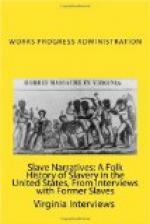“I do not know about the young generation. I am old and crippled and don’t go out none.”
Interviewer: Mrs. Bernice Bowden
Person interviewed: Griffin Myrax
913
Missouri Street, Pine Bluff, Arkansas
Age 77?
“I don’t know my age exactly. You know in them days people didn’t take care of their ages like they do now. I couldn’t give you any trace of the war, but I do remember when the Ku Klux was runnin’ around.
“Oh Lord, so much of the time I heard my mother talk about the slavery. I was born in Oklahoma and my grandfather was a full-blooded Crete Indian. He was very much of a man and lived to be one hundred thirty years old. All Crete Indians named after some herb—that’s what the name Myrax means.
“I heard my mother say that in slavery times the man worked all day with weights on their feet so when night come they take them off and their feet feel so light they could outran the Ku Klux. Now I heard her tell that.
“My parents moved from Oklahoma to Texas and I went to school in Marshall, Texas. All my schoolin’ was in Texas—my people was tied up there. My last schoolin’ was in Buchanan, Texas. The professor told my mother she would have to take me out of school for awhile, I studied too hard. I treasured my books. When other children was out playin’ I was studyin’.
“There was some folks in that country that didn’t get along so well. I remember there was a blind woman that the folks sent something to eat by another colored woman. But she eat it up and cooked a toadfrog for the old blind woman. That didn’t occur on our place but in the neighborhood. When the people found it out they whipped her sufficient.
“When my grandfather died he didn’t have a decayed tooth in his head. They was worn off like a horse’s teeth but he had all of them.
“I always followed sawmill work and after I left that I followed railroading. I liked railroading. I more or less kept that in my view.
“About this slavery—I couldn’t hardly pass my sentiments on it. The world is so far gone, it would be the hardest thing to put the bridle on some of the people that’s runnin’ wild now.”
Name of Interviewer: Irene Robertson
Subject: Ex-slaves—Dreams—Herbs:
Cures and Remedies
Story:—
This information given by: Tom Wylie Neal
Place of Residence: Hazen, Arkansas—Near
Green Grove
Occupation: Farmer—Feeds cattle in
the winter for a man in Hazen.
Age: 85
[TR: Information moved from bottom of first page.]
His father and mother belonged to Tom Neal at Calhoun, Georgia. He remembers the big battle at Atlanta Ga. He was eight years old. He saw the lights, [saw the bullets in the air at night] and heard the boom, boom of guns and cannons. They passed along with loaded wagons and in uniforms. The horses were beautiful, and he saw lots of fine saddles and bridles. His mistress’ name was Mrs. Tom




